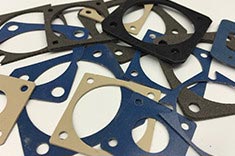EMI Shielding Products
- Custom Gasket Fabrication
- Connector Gaskets
- Bonded O Ring
- Custom Gaskets
- Conduct-O-Knit Knitted Wire Mesh
- Conduct-O-Seal Combo Gasket
- Conduct-O-Elastomer
- Conduct-O-Seal Oriented Wire in Silicone Gasket Material
- Conduct-O-Mesh Tape
- Conduct-O-Foam
- Conduct-O-Bond
- Optical Filters For Electronic Displays
- Shielded Vent Panels
- ESC Board Level Shielding
- 300 Series
How does EMI Shielding Work
EMI shielding functions as a conductive barrier that encloses electrical circuits as a means of providing isolation. A shield is a continuous conductive enclosure constructed from a sufficient material and thickness. These conducive boxes have no openings. The point of EMI RFI shielding is to deal with radiated energies from internal and external sources.

To understand the effectiveness of shielding, it is important to know two terms. SE (shielding effectiveness) is the ratio of radio-frequency energy on one side of the shield, and dB (decibels) refers to the RF energy on the other side.
Sources that come from outside the shield show reflection and absorption through dB readings. These numbers are added to generate the sum of SE for the shield.
To control the absorption of the shielding material at frequencies of concern, you must determine thickness, conductivity, and permeability. To determine the reflectivity of material at frequencies of concern, you only need to consider permeability and conductivity.
EMI RFI Shielding
Shielding is also considered non-invasive in that it does not negatively affect the performance of high-speed operations. It also works for both RFI and EMI susceptibility and emission. It is often used as a cost-effective solution when used in conjunction with other suppression techniques (grounding, filtering, and design). To help with suppression, it is important to minimize the loop area during the design stages. Shielding can be added to a device after the design is finished, but it is more efficient and cost-effective to design EMI shields into the original design.
Related Reading- Do My Electronics Require EMI RFI ShieldingTo avoid any issues in design and performance, it is important to incorporate EMI and RFI regulations with EMI shielding at the component level.
- How do I Test EMI RFI Shielding
- Why do Engineers Use EMI RFI Shielding



